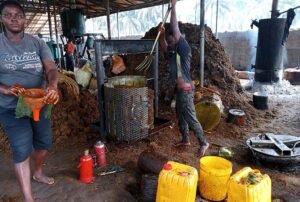
In June 2023, attorney Lisa Johnson entered the Washington County Court of Common Pleas in the heart of fracking country in southwestern Pennsylvania, armed with a novel legal theory she believed could be used to hold the oil and gas giant Chevron accountable.
One year later, the Supreme Court has overruled its landmark 1984 decision in Chevron v. Natural Resources Defense Council, making it harder for regulatory agencies and environmental law firms to hold large industry accountable. But in her own fight against Chevron, Johnson believes she is opening up an entirely new legal front in the countrywide fight against the oil and gas industry.
Johnson is not part of a giant firm, and I have not seen her with a paralegal; she answers her phone herself. Chevron, meanwhile, is where a spokesperson once famously stated, regarding a case involving oilfield contamination in Indigenous communities in the Ecuadorian rainforest: “We’re going to fight this until hell freezes over. And then we’ll fight it out in the ice.”
Growing up in rural northeast Pennsylvania, Johnson said in an interview, “I always wanted to help, but not coming from means and not having access, I didn’t know how, and I didn’t know anything about the law.” She received partial tuition for law school by first becoming a police officer, and after graduating at the top of her law school class, she initially worked with oil, gas, and pipeline companies. “I started realizing these projects were invasive and harmful against the people of Pennsylvania,” she said, “and then I read the IPCC climate change report and Jane Mayer’s book Dark Money, and I was radicalized.”
Fighting the oil and gas industry in court on climate change has been difficult. Cases in which cities sue the industry for causing heat waves, states sue for being deceived on climate impacts, or children sue for the destruction of their future draw a lot of media attention. But these cases don’t always win.
Johnson aimed for a very different tactic. “The legal theory is there are certain substances or activities that have been considered abnormally dangerous,” she said. “That means we don’t have to prove the harm associated with them; they are automatically deemed harmful by the court.”
The industry generates about three billion gallons of brine a day.
The entity or corporation invoking that harm has what is known as “strict liability”—they cannot claim that they did not know an activity was harmful because when something is considered abnormally dangerous, the corporation has a legal responsibility to know it is harmful. In her case against Chevron, Johnson zeroed in on radium.
Radioactivity and the Industry
Over the last seven years, I’ve investigated oilfield radioactivity, and in April 2024, my book, Petroleum-238: Big Oil’s Dangerous Secret and the Grassroots Fight to Stop It, was published on the topic. Unknown to many people, the oil and gas industry brings incredible amounts of waste to the surface in its operations, which consists largely of natural materials concentrated with contaminants. The industry’s processes can concentrate them even further once they are extracted.
The primary waste stream is an extremely salty liquid called oilfield brine or produced water. The industry generates about three billion gallons of brine a day. If a year’s worth were filled into oil barrels and stacked atop one another, they would reach the moon and back nearly 28 times. This brine can also contain elevated levels of heavy metals like lead and arsenic and be rich in the radioactive metal radium.
Radium is regarded as a “bone-seeker” because it has a chemical makeup similar to calcium. If accidentally inhaled or ingested, it tends to accumulate in bones. Pennsylvania Department of Environmental Protection data indicate radium levels in the Marcellus Shale Formation—the site of drilling in southwestern Pennsylvania—can average 9,330 picocuries per liter (pCi/L) and be as high as 28,500 pCi/L. For context, EPA’s safe drinking water limit for radium is 5 pCi/L, and at 60 pCi/L EPA formally defines a liquid waste stream as “radioactive.”
The industry knows about the radioactivity problem. “Almost all materials of interest and use to the petroleum industry,” stated a 1982 report of the American Petroleum Institute’s Department of Medicine and Biology, “contain measurable quantities of radionuclides that reside finally in processing equipment, product streams, or waste.”
Even Chevron has expressed that there are risks. A 1991 paper by scientists with the Chevron Environmental Health Center and published with the Society of Petroleum Engineers warns of harm from the two of the most common forms, or isotopes, of radium.
“A number of health and safety issues have arisen because of the occurrence of…naturally occurring radioactive materials of the 226 radium and 228 radium decay chains, in production operations,” the Chevron paper stated. “Issues such as risk to workers or the general public” and the disposal of contaminated materials “must be addressed.”
A 1994 paper on oilfield radioactivity and its associated liability by Chevron attorney David Martindale stated: “If radium in sufficient quantities is taken into the body by inhalation or ingestion, alpha particles ejected from the radium atoms inside of the body can be harmful.”
“There is no one federal agency that specifically regulates the radioactivity brought to the surface by oil and gas development.”
Chevron has not replied to questions regarding its knowledge of oilfield radioactivity, risks alleged in Johnson’s case, or earlier cases on the issue. But communities and oilfield workers trying to hold the industry accountable for their radioactive waste face several regulatory barriers.
In 1976, Congress passed the Resource Conservation and Recovery Act (RCRA), an attempt to deal with the nation’s hazardous waste crisis by creating rules to properly transport and dispose of it. But the 1980 Bentsen and Bevill Amendments provided the oil and gas industry with a gift by legally defining oilfield waste—despite being potentially loaded with radioactivity and a host of other carcinogens—as non-hazardous “special waste” under RCRA regulations.
After the use of nuclear weapons in World War II, radioactivity was to be regulated by the US Atomic Energy Commission and later the Nuclear Regulatory Commission. While radiation generated in nuclear energy and medicine were included in regulations, oilfield radioactivity was not. As the US Environmental Protection Agency said in an interview, “EPA does not regulate radioactivity in oil and gas production, processing and transport systems….There is no one federal agency that specifically regulates the radioactivity brought to the surface by oil and gas development.”
Sign up for our free newsletters
Subscribe to NPQ's newsletters to have our top stories delivered directly to your inbox.
By signing up, you agree to our privacy policy and terms of use, and to receive messages from NPQ and our partners.
Dangerous Impoundments
Fracking has only added to the oilfield waste problem by bringing drilling closer to communities, increasing the volume of waste, and adding new waste streams like flowback, which surges to the surface and may contain elevated levels of heavy metals and radioactivity. Despite the concerning brew of contaminants in brine and flowback, in Pennsylvania it remains common practice to store the waste onsite in gigantic lined ponds called impoundments, located adjacent to the well but also to homes, farmland, and communities. The Pennsylvania attorney general, in a Grand Jury investigation into the fracking industry released in 2020, called impoundments an “outmoded regulatory approach” that could contain “exotic, complex chemical compounds, many of which may have serious health consequences.”
In her case, Johnson alleged that wastewater from an impoundment flooded the backyard of Bryan Latkanich and his sons, leaving wastewater pooled against their home; cracking and shifting the home’s foundation; ruining the property; contaminating their water and air; and exposing them to fracking chemicals, radioactivity, and other contaminants. The family was “sickened by such exposures,” according to the lawsuit.
Johnson has argued that the family was exposed to radium from the impoundment in the air they breathed and the water they drank from their well. She cited a 1991 New Jersey case, T E Industries v. Safety Light Corp., in which the Supreme Court of New Jersey ruled that “radium is a per se ‘abnormally dangerous’ substance.” Because radium is considered abnormally dangerous in New Jersey it should also be considered abnormally dangerous in Pennsylvania, which means Chevron or any other oil and gas company would be strictly liable for that.
A Legal History
There is an earlier arc to this legal tactic that goes back to a New Orleans attorney named Stuart Smith. Born in New Orleans, Smith dropped out of high school at age 15, but, pushed by a hardworking mother, eventually graduated law school. He was motivated for justice after an accident in which his younger brother was hit by a car and then dropped while being lifted into the ambulance. “I wanted to hold people accountable for hurting others,” he wrote in a book about his life called Crude Justice. And he wanted to “fight big corporations.”
Smith’s introduction to oilfield radioactivity came in 1989 when he took a cold call from a man named Winston Street. Street ran a backyard operation that cleaned hardened mineral scale out of oilfield pipes from companies like Shell and Chevron. Chiseling out this scale generates massive amounts of dust, which could coat these pipe-cleaning yards like snowfall inches or even feet thick. It coated workers’ clothes too, and invariably got breathed in and coated their lungs.
Workers typically wore no protective gear and did not know that the dust they were generating as they removed the scale stuck to the inside of the pipes contained the radioactive element radium. In taking Street’s case, Smith’s task was to convince the court that oil companies knew the pipes were filled with dangerous amounts of radioactivity but hid it from workers and that this radioactivity contaminated not just them but their families, too.
According to Smith’s account, one worker testified in court that “it had been the nastiest job he’d ever worked in his life, with thick scale coating his overalls and getting in his mouth.” A 1987 article published in the Society of Petroleum Engineers’ Journal of Petroleum Technology pointed out that when cleaned, the scale is crumbled into “flakes” and then distributed across the yard. According to the article, the radiation dose these workers received was high enough that they would exceed annual Nuclear Regulatory Commission limits for non-nuclear industry workers in only three days.
Smith’s court case also introduced the example of Karen, a 26-year-old wife of one oilfield pipe cleaner (and daughter-in-law of Winston Street), whose hip cracked in half while she was pregnant. One of Street’s pipe-cleaning operations was located behind her home, and tests showed the soil in their vegetable garden had become contaminated with radium. A doctor “confirmed that Karen was suffering from severe radium-induced bone necrosis,” wrote Smith.
In the end, Smith persisted against what he referred to as Chevron’s “scorched earth policy” and he won the case. He went on to win a record $1 billion lawsuit against Exxon Mobil (the settlement was later whittled down). Having garnered a reputation as a knowledgeable attorney on radiation issues, he carried his firm into other complex environmental legal terrain, including contamination from nuclear weapons production and the 2010 BP oil spill.
“They’ve been fracking here for 20 years…and this is the first time we have had our day in court.”
In 2023, Smith passed away from cancer. Once when asked, given all his success and the industry’s vulnerability on the issue, why no other attorneys had entered the oilfield radioactivity game, he told me, “The learning curve on a case like this is tremendous. And your average attorney is not going to be able to handle it.”
But with Johnson, that may be changing.
Time Is Running Out
The next proceeding in Johnson’s case against Chevron in Pennsylvania will be a hearing on August 2, 2024. The goal here, she noted, is to show the court that it was indeed Chevron Corporation making the decisions regarding what happened to the fracking waste impoundment on the Latkaniches’ land and not one of the California-based company’s many subsidiaries. When asked if the case might go to trial anytime soon, Johnson said no. A trial was at least a year and a half away.
It’s time her clients do not have. Bryan Latkanich has serious heart, kidney, and spleen conditions—his organ systems are failing—and has recently been told by his doctors that he may only have months left to live.
One thing that is certain for now: Johnson’s work has already been acknowledged and appreciated by the people of southwestern Pennsylvania. “Everyone here was impacted by the Marcellus Shale,” a southwestern Pennsylvania resident named Cat Lodge told me last June at the Washington County Court of Common Pleas. Lodge works with a watchdog organization called the Environmental Integrity Project.
“They’ve been fracking here for 20 years,” she told me, “and this is the first time we have had our day in court.”
Meanwhile, with the Supreme Court poised to continue to deliver rulings that favor corporations, using the legal concept of strict liability to hold the industry accountable for its radioactive waste offers a type of due diligence. Such a tactic may be more appealing to courts considering taking up these cases.
And that, according to Johnson, has the potential to change everything.









